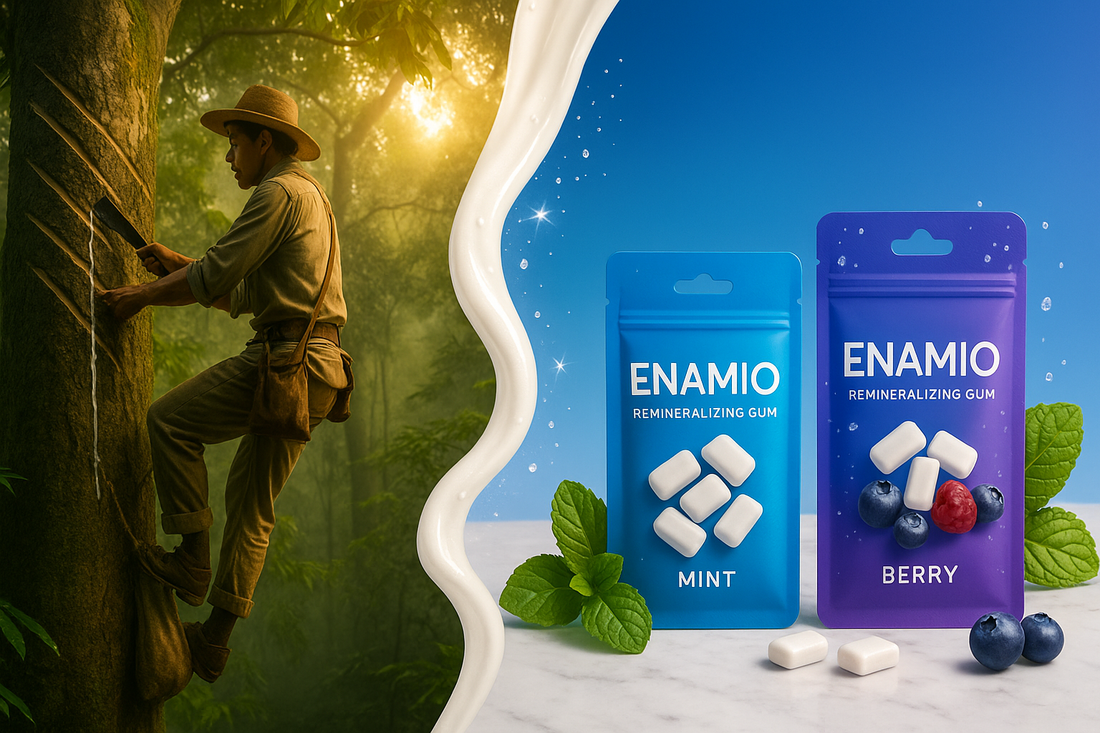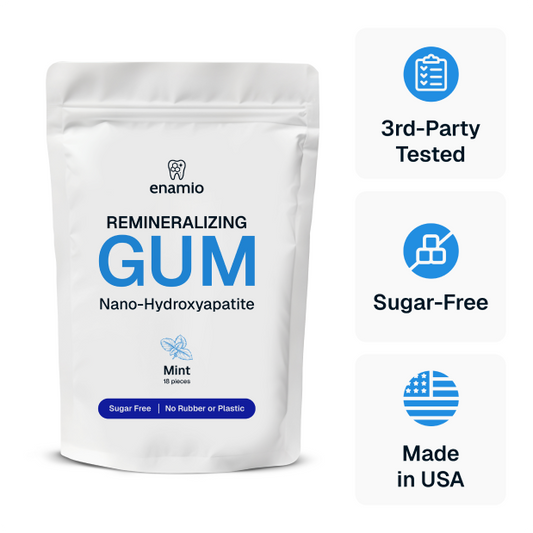
Chewing Gum Made of Chicle: Ancient Tree Sap vs Plastic [2025 Guide] | Enamio
Share
Chewing Gum Made of Chicle: The Ancient Tree Sap Revolution That's Saving Your Teeth (And The Planet)
Chewing gum made of chicle is plastic‑free by design, tapped from the sapodilla tree and refined into a natural, biodegradable gum base. Below, you’ll see exactly how chicle differs from synthetic “gum base,” what the science says about enamel health, and why Enamio’s nano‑hydroxyapatite chicle formula is built for measurable results—not hype.
📚 Table of Contents
- The Ancient Maya & Aztec Origin of Chicle
- What “Gum Base” Really Means (and Why It Matters)
- Chicle Science: Natural Latex, Polyisoprene & Fast Biodegradation
- How Chicle Is Harvested Sustainably
- Environmental Reality Check (with credible stats)
- Oral‑Health Benefits: Saliva, Xylitol & n‑HA
- How to Use Chicle Gum for Better Results
- Enamio vs. Simply Gum, Glee Gum, PUR, quip
- Ingredient → Mechanism → Evidence → Benefit
- Why Enamio’s Chicle + Nano‑Hydroxyapatite Formula Is Different
- Rainforest Stewardship & Co‑op Sourcing
- How to Choose Real Chicle Gum (Avoid Greenwashing)
- People Also Ask
- FAQ
- References
- TL;DR
🔑 Key Takeaways
- Chicle is a natural, plant‑based gum base tapped from sapodilla trees—no petroleum polymers or PVAc.
- Biodegradation is fast for chicle (as little as ~6 weeks in brand tests), unlike synthetic gum that persists for years.
- Enamio = chicle + 20‑nm nano‑hydroxyapatite (n‑HA) plus CaGP and L‑arginine—built to support enamel remineralization during chewing (without over‑promising).
- Sourcing protects forests through Mexican cooperatives managing ~1.3 million hectares of rainforest with Rainforest Alliance/FSC roots.
- Why Enamio? Based on publicly available info (Sept 2025), Enamio discloses one of the highest nano‑HA payloads of any chewing gum—and mainstream plastic‑free chicle brands do not include n‑HA.
The Ancient Maya & Aztec Origin of Chicle
For millennia, Maya and Aztec communities chewed chicle—latex from the sapodilla (Manilkara) tree—for fresher breath and a cleaner mouth. Historical sources note social etiquette around public chewing in Aztec society, yet also document its practical oral‑hygiene role. (Maya/etiquette context; Aztec etiquette)
What “Gum Base” Really Means (and Why It Matters)
Most conventional “gum base” is a blend of synthetic polymers and resins—polyvinyl acetate (PVAc), elastomers (e.g., styrene‑butadiene), waxes and resins—permitted under 21 CFR §172.615. That’s not inherently unsafe, but it is plastic‑derived and not biodegradable like chicle. Meanwhile, sugar‑free gums accepted by the ADA emphasize xylitol/sorbitol for oral benefits—but do not guarantee a plastic‑free base. (ADA chewing gum overview)
Gum litter has real civic costs. UK sources estimate councils spend ~£7 million/year cleaning gum off streets, with 77–87% of England’s streets stained by gum. (UK Gov / Keep Britain Tidy data) Singapore famously restricted gum sales in 1992 (therapeutic exceptions since 2004) to reduce damage and cleanup costs. (Singapore regulations)
Chicle Science: Natural Latex, Polyisoprene & Fast Biodegradation
Natural chicle is a milky latex rich in polyisoprene chains (elasticity) and plant resins (cohesion). Unlike PVAc‑based bases, chicle is biodegradable—press reports around co‑op brand Chicza describe breakdown in “as little as six weeks” under environmental conditions. (Guardian, Telegraph)
Want the deep science on remineralization? See our explainer on nano‑hydroxyapatite gum science and our complete guide to remineralizing gum.
Make the Switch to Plastic‑Free Chicle
Enamio pairs sustainable chicle with 20‑nm nano‑hydroxyapatite for enamel support while you chew
Try Enamio Remineralizing Chicle Gum →⭐⭐⭐⭐⭐ 4.8/5 from 450+ verified customers
How Chicle Is Harvested Sustainably
Chicleros make diagonal zig‑zag cuts on sapodilla bark; latex flows into cups and is later boiled into blocks. Trees are allowed to rest ~6–8 years between tappings—a cycle compatible with long‑term forest health. (Rainforest Alliance)
Environmental Reality Check (with credible stats)
| Factor | Chicle Gum (Enamio) | Conventional Synthetic Gum |
|---|---|---|
| Base Material | Sapodilla latex (plant‑based) | Petroleum‑derived polymers (e.g., PVAc) |
| Biodegradability | Breakdown reported in weeks (brand tests) | Persists for years; urban cleanup burden |
| Forest Impact | Incentivizes standing forests via co‑ops | No forest stewardship linkage |
| Public Litter Context (UK) | — | ~£7m/yr cleanup; 77–87% of streets stained |
Mexican co‑ops organized under the Consorcio Chiclero steward ~1.3 million hectares of rainforest across the Yucatán/Gran Petén region, with roots in Rainforest Alliance/FSC certification for chicle (first non‑timber forest product certified in 1999). (Consorcio interview; Rainforest Alliance; FSC NTFP note)
Oral‑Health Benefits: Saliva, Xylitol & Nano‑Hydroxyapatite
Chewing sugar‑free gum stimulates saliva (ADA), neutralizes acids, and helps clear food debris. Xylitol can reduce S. mutans levels and support caries risk reduction when used consistently and at adequate daily intake. (ADA overview; xylitol review; dose‑response trial)
Nano‑hydroxyapatite (n‑HA) is biomimetic enamel mineral. Clinical and in situ studies show n‑HA can remineralize early lesions and reduce dentin hypersensitivity—making it a compelling active for chewing delivery where saliva flow is elevated. (n‑HA review 2022; RCT on sensitivity; remineralization dentifrice) Japan recognized hydroxyapatite as an anti‑caries agent in the early 1990s. (context, n‑HA efficacy)
How to Use Chicle Gum for Better Results
- Chew 1 piece right after meals, 2–3×/day (10–20 minutes each session) to stimulate saliva and deliver actives.
- For sensitivity/white‑spot support, use consistently for 8–12 weeks and reassess. Pair with gentle brushing and flossing.
- Avoid chewing immediately before brushing if abrasivity is a concern; let enamel surface reharden post‑meal first.
For step‑by‑step timing, see How to Use Remineralizing Gum (Guide).
Enamio vs. Simply Gum, Glee Gum, PUR, quip
| Brand | Base Type | Plastic‑Free Base | n‑HA Included? | Xylitol? | Notes / Source |
|---|---|---|---|---|---|
| Enamio | Chicle + candelilla | Yes | Yes (20‑nm) | Yes | Remineralizing chicle gum with n‑HA, CaGP, L‑arginine. Product |
| Simply Gum | Chicle | Yes | No | Varies | Brand page (chicle) |
| Glee Gum | Chicle (lists base) | Yes | No | Yes (sugar‑free SKUs) | Glee & chicle · Ingredients example |
| PUR Gum | Unspecified “gum base” | Unclear | No | Yes | Brand site lists xylitol; base not detailed. (PUR) |
| quip Gum | Unspecified “gum base” | Unclear | No | Yes | ADA‑accepted sugar‑free gum with xylitol; base not specified. (quip) |
Takeaway: Enamio is positioned for enamel support (n‑HA + CaGP + arginine) on a plastic‑free chicle base. Simply Gum/Glee Gum are good plastic‑free options but lack remineralizing actives. PUR and quip emphasize xylitol; they do not disclose a plastic‑free base or n‑HA.
Ingredient → Mechanism → Evidence → Practical Benefit
| Ingredient | Mechanism | Key Evidence | What You Feel |
|---|---|---|---|
| 20‑nm Nano‑Hydroxyapatite | Biomimetic enamel crystals; occlude pores; replenish mineral | Review (2022); Remin study; RCT on sensitivity | Smoother feel; sensitivity relief over weeks |
| Calcium Glycerophosphate (CaGP) | Bioavailable Ca/PO4 reservoir; buffers acid | CaGP remineralization review | Supports mineral balance |
| L‑Arginine (as bicarbonate) | Feeds ADS‑positive bacteria → ammonia → pH rise | ADS/caries link; ADA+JDR+ evidence | Less acid challenge post‑meal |
| Xylitol (USP) | Non‑fermentable; reduces S. mutans counts with consistent dose | Systematic review; Dose–response | Fresher breath; supports caries risk reduction |
| Matcha Extract, Zinc, Bamboo Silica, Mg | Adjunct biofilm control; trace mineral support | Supportive/adjunct literature | Clean, polished feel after chewing |
Why Enamio’s Chicle + Nano‑Hydroxyapatite Formula Is Different
Enamio combines plastic‑free chicle with a 20‑nm, carbonate‑substituted n‑HA that mirrors enamel mineral. As you chew, saliva flow increases delivery of n‑HA, CaGP and L‑arginine to the biofilm, supporting pH balance and mineral redeposition between brushings. Based on public product disclosures as of Sept 2025, mainstream chicle gums like Simply Gum and Glee Gum do not include n‑HA—this is where Enamio stands apart.
🌟 Enamio’s Remineralizing Build
- Chicle + Candelilla Base — 100% plant‑based foundation
- 20‑nm Nano‑Hydroxyapatite — enamel‑like crystals for lesion filling
- Calcium Glycerophosphate — mineral reservoir and buffering
- L‑Arginine (bicarbonate) — supports alkali generation (ADS)
- Xylitol (USP) — non‑fermentable sweetener; supports MS reduction
- Matcha, Zinc Gluconate, Bamboo Silica, Mg Citrate — adjuncts for biofilm balance and smooth feel
Rainforest Stewardship & Co‑op Sourcing
Enamio sources chicle through cooperatives in Quintana Roo linked to the Consorcio Chiclero—an organization coordinating ~2,000 chicleros across ~1.3 million hectares of rainforest. Rainforest Alliance recognized chicle in 1999 as its first non‑timber forest product certification in the Yucatán. (Consorcio Chiclero interview; Rainforest Alliance)
How to Choose Real Chicle Gum (Avoid Greenwashing)
- Look for “chicle” or “sapodilla latex” in the base—not generic “gum base.”
- Check for actives, not just sweeteners: n‑HA, CaGP, L‑arginine beat “xylitol‑only.”
- Ask for biodegradability evidence (brands like Chicza have published claims/tests).
- Verify co‑op or certification ties: Rainforest Alliance/FSC context indicates stewardship.
- Inspect label transparency: Enamio lists base and actives openly.
🤔 People Also Ask
- Is chicle gum plastic‑free? Yes—chicle is tree latex, not petroleum polymer.
- How long does chicle take to biodegrade? Brand tests report breakdown in weeks; conditions vary.
- Does n‑HA gum help enamel? Evidence shows n‑HA supports remineralization; gum delivery leverages saliva.
- What about xylitol dose? Studies use multiple daily exposures; see our xylitol guide.
- Is synthetic gum “bad”? Not necessarily—but it’s rarely biodegradable and often plastic‑derived.
Try the Only Chicle Gum Built for Remineralization
High‑disclosure, high‑science formula with nano‑hydroxyapatite—plus CaGP and L‑arginine
Shop Enamio Remineralizing Chicle Gum →✓ 30‑Day Money Back Guarantee • Free Shipping $50+
📚 Continue Learning
Best Remineralizing Gum: Science‑First Buyer’s Guide
How to evaluate ingredients, doses, and claims.
Nano‑Hydroxyapatite Gum: The Science
What n‑HA size/shape matters—and why.
How to Use Remineralizing Gum (2025 Guide)
Timing, frequency, and stacking with toothpaste.
Enamio Ingredients: Evidence‑Based Breakdown
Every active, explained with citations.
Found This Helpful? Share It
Frequently Asked Questions
What is chewing gum made of chicle?
It’s natural latex tapped from the sapodilla tree (Manilkara). The sap is collected via diagonal cuts, then gently cooked into gum base. It’s plastic‑free and biodegradable.
Does chicle gum biodegrade?
Yes. Reports around co‑op brand testing suggest breakdown in weeks under environmental conditions. Time varies with climate and disposal conditions.
Is n‑HA gum safe and effective?
Clinical/in‑situ evidence supports n‑HA for early‑lesion remineralization and sensitivity relief. We avoid over‑claims; gum is a helpful adjunct, not a cure‑all.
How often should I chew Enamio?
Chew 1 piece right after meals, 2–3×/day for 10–20 minutes. See our full usage guide.
Is chicle safe for kids?
Yes, when used as directed. It’s non‑toxic and plastic‑free. Always supervise young children to prevent choking.
📝 TL;DR
Chicle = tree‑sap gum base that biodegrades; synthetic “gum base” is usually plastic‑derived. Enamio pairs chicle with nano‑hydroxyapatite, CaGP, and L‑arginine to support enamel during the most saliva‑rich part of your day—chewing. If you want plastic‑free gum with real oral‑health actives, this is it.
About This Article
Written by: Enamio Science Review Team • Last Updated: September 13, 2025
Our Clinical Review group synthesizes peer‑reviewed evidence on remineralization actives (n‑HA, CaGP, arginine, xylitol).
References
- 21 CFR §172.615 — Chewing gum base (FDA e‑CFR).
- American Dental Association (2023): Chewing gum topic page.
- Rainforest Alliance: Sapodilla & chicle (1999 NTFP certification).
- Consorcio Chiclero interview (1.3M ha; co‑op scale).
- FSC/NTFP note: chicle as first NTFP under FSC (1999).
- UK Gov/Keep Britain Tidy: £7m/yr cleanup; 77–87% streets stained.
- Singapore: Regulation of Imports & Exports (Chewing Gum).
- Guardian (2009): Biodegradable chicle gum claims (~6 weeks); Telegraph (2009).
- Anil et al. 2022: n‑HA remineralization review; Vano et al. 2018: sensitivity RCT; Najibfard et al. 2011: remin dentifrice.
- Janakiram et al. 2017: xylitol systematic review; Milgrom et al. 2006: dose‑response trial.
- ADA/JDR+ 2023: arginine overview & trials; Nascimento et al. 2013: ADS, pH & caries.
- Simply Gum — chicle explainer; Glee Gum — chicle background; quip gum page.
- Yucatán Today (2025): Maya/Aztec chewing; TodayIFoundOut: etiquette note.

